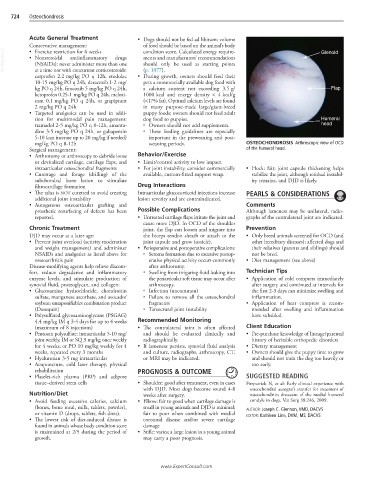Page 1427 - Cote clinical veterinary advisor dogs and cats 4th
P. 1427
724 Osteochondrosis
Acute General Treatment • Dogs should not be fed ad libitum; volume
Conservative management: of food should be based on the animal’s body Glenoid
VetBooks.ir • Nonsteroidal antiinflammatory drugs ments and manufacturers’ recommendations
condition score. Calculated energy require-
• Exercise restriction for 6 weeks
should only be used as starting points
(NSAIDs): never administer more than one
at a time nor with concurrent corticosteroids:
(p. 1077).
carprofen 2.2 mg/kg PO q 12h, etodolac • During growth, owners should feed their
10-15 mg/kg PO q 24h, deracoxib 1-2 mg/ pets a commercially available dog food with
kg PO q 24h, firocoxib 5 mg/kg PO q 24h, a calcium content not exceeding 3.5 g/ Flap
ketoprofen 0.25-1 mg/kg PO q 24h, meloxi- 1000 kcal and energy density < 4 kcal/g
cam 0.1 mg/kg PO q 24h, or grapiprant (<17% fat). Optimal calcium levels are found
2 mg/kg PO q 24h in many purpose-made large/giant-breed
• Targeted analgesics can be used in addi- puppy foods; owners should not feed adult
tion for multimodal pain management: dog food to puppies. Humeral
tramadol 2-5 mg/kg PO q 8-12h, amanta- ○ Owners should not add supplements. head
dine 3-5 mg/kg PO q 24h, or gabapentin ○ These feeding guidelines are especially
5-10 (can increase up to 20 mg/kg if needed) important in the preweaning and post-
mg/kg PO q 8-12h weaning periods. OSTEOCHONDROSIS Arthroscopic view of OCD
Surgical management: of the humeral head.
• Arthrotomy or arthroscopy to debride loose Behavior/Exercise
or devitalized cartilage, cartilage flaps, and • Limit/control activity to low impact.
intraarticular osteochondral fragments • For joint instability, consider commercially • Hock: fair; joint capsule thickening helps
• Curettage and forage (drilling) of the available, custom-fitted support wrap. stabilize the joint, although residual instabil-
subchondral bone lesion to stimulate ity remains, and DJD is likely.
fibrocartilage formation Drug Interactions
• The talus is NOT curetted to avoid creating Intraarticular glucocorticoid injections increase PEARLS & CONSIDERATIONS
additional joint instability lesion severity and are contraindicated.
• Autogenous osteoarticular grafting and Comments
prosthetic resurfacing of defects has been Possible Complications Although lameness may be unilateral, radio-
reported. • Untreated cartilage flaps irritate the joint and graphs of the contralateral joint are indicated.
cause more DJD. In OCD of the shoulder
Chronic Treatment joint, the flap can loosen and migrate into Prevention
DJD may occur at a later age: the biceps tendon sheath or attach to the • Only breed animals screened for OCD (and
• Prevent joint overload (activity moderation joint capsule and grow (ossicle). other hereditary diseases); affected dogs and
and weight management) and administer • Perioperative and postoperative complications: their relatives (parents and siblings) should
NSAIDs and analgesics as listed above for ○ Seroma formation due to excessive postop- not be bred.
osteoarthritis pain erative physical activity occurs commonly • Diet management (see above)
Disease-modifying agents help relieve discom- after arthrotomy.
fort, reduce degradative and inflammatory ○ Swelling from irrigating fluid leaking into Technician Tips
enzyme levels, and stimulate production of the periarticular soft tissue may occur after • Application of cold compress immediately
synovial fluid, proteoglycan, and collagen: arthroscopy. after surgery and continued at intervals for
• Glucosamine hydrochloride, chondroitin ○ Infection (uncommon) the first 2-3 days can minimize swelling and
sulfate, manganese ascorbate, and avocado/ ○ Failure to remove all the osteochondral inflammation.
soybean unsaponifiables combination product fragments • Application of heat compress is recom-
(Dasuquin) ○ Tarsocrural joint instability mended after swelling and inflammation
• Polysulfated glycosaminoglycans (PSGAG) have subsided.
4.4 mg/kg IM q 3-4 days for up to 4 weeks Recommended Monitoring
(maximum of 8 injections) • The contralateral joint is often affected Client Education
• Pentosan polysulfate: intraarticular 5-10 mg/ and should be evaluated clinically and • Pre-purchase knowledge of lineage/parental
joint weekly, IM or SQ 3 mg/kg once weekly radiographically. history of heritable orthopedic disorders
for 4 weeks, or PO 10 mg/kg weekly for 4 • If lameness persists, synovial fluid analysis • Dietary management
weeks, repeated every 3 months and culture, radiographs, arthroscopy, CT, • Owners should give the puppy time to grow
• Hyaluronan 3-5 mg intraarticular or MRI may be indicated. and should not train the dog too heavily or
• Acupuncture, cold laser therapy, physical too early.
rehabilitation PROGNOSIS & OUTCOME
• Platelet-rich plasma (PRP) and adipose SUGGESTED READING
tissue–derived stem cells • Shoulder: good after treatment, even in cases Fitzpatrick N, et al: Early clinical experience with
with DJD. Most dogs become sound 4-8 osteochondral autograft transfer for treatment of
Nutrition/Diet weeks after surgery. osteochondritis dissecans of the medial humeral
• Avoid feeding excessive calories, calcium • Elbow: fair to good when cartilage damage is condyle in dogs. Vet Surg 38:246, 2009.
(bones, bone meal, milk, tablets, powder), small in young animals and DJD is minimal; AUTHOR: Joseph C. Glennon, VMD, DACVS
or vitamin D (drops, tablets, fish diets). fair to poor when combined with medial EDITOR: Kathleen Linn, DVM, MS, DACVS
• The lowest risk of diet-induced disease is coronoid disease and/or severe cartilage
found in animals whose body condition score damage
is maintained at 2/5 during the period of • Stifle: varies; a large lesion in a young animal
growth. may carry a poor prognosis.
www.ExpertConsult.com

